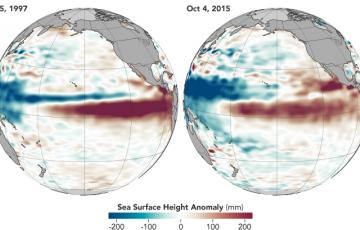Feature Publication Archive

A comparison of the 2015 and 1997 El Niños. Credit: NASA’s Earth Observatory.
Levine, A. F. Z., and M. J. McPhaden (2016), How the July 2014 Easterly Wind Burst Gave the 2015-6 El Niño a Head Start, Geophys. Res. Lett., 43, doi:10.1002/2016GL069204.
Following strong westerly wind bursts in boreal winter and spring of 2014, both the scientific community and the popular press were abuzz with the possibility of a major El Niño developing, but the widely anticipated major 2014-5 El Niño event didn't even qualify as an El Niño by conventional definitions.
The boreal summer easterly wind burst inhibited the growth of the El Niño event, and also prevented and then reversed the discharge of the equatorial heat content that typically occurs during the course of an El Niño event. This head start of equatorial heat content helped push the... more »
McPhaden, M.J., A. Timmermann, M.J. Widlansky, M.A. Balmaseda, and T.N. Stockdale (2015): The curious case of the El Niño that never happened: A perspective from 40 years of progress in climate research and forecasting. Bull. Am. Meteorol. Soc., 96, 1647–1665, doi: 10.1175/BAMS-D-14-00089.1.
Forty years ago, an “El Niño Watch” expedition was launched to the eastern equatorial Pacific to document oceanographic changes that were expected to develop during the onset of an El Niño event in early 1975.
An initial warming was detected, but it quickly dissipated. Why did the initial warming fail to amplify into a full blown El Niño?
This paper provides a perspective from 40 yars of progress in climate research and forecasting.
With the benefit of hindsight, the authors provide a basin-scale context for what the expedition observed, elucidate the dynamical... more »
McPhaden, M.J. (2015): Playing hide and seek with El Niño. Nature Clim. Change, 5, 791–795, doi:10.1038/nclimate2775.
The scientific community and the popular press were abuzz in early 2014 with the possibility that a “monster” El Niño was incubating in the tropical Pacific. Oceanic and atmospheric conditions then suggested similarities with the onset of the 1997/98 El Niño, which is the strongest on record. Model forecasts from the early months of 2014 were also consistent in predicting development of El Niño conditions as the year progressed.
But then the big El Niño went bust, defying conventional wisdom and the computer model forecasts. Why this happened is a mystery that has left the experts... more »
Cai, W., A. Santoso, G. Wang, S.-W. Yeh, S.-I. An, K.M. Cobb, M. Collins, E. Guilyardi, F.-F. Jin, J.-S. Kug, M. Lengaigne, M.J. McPhaden, K. Takahashi, A. Timmermann, G. Vecchi, M. Watanabe, and L. Wu (2015): ENSO and greenhouse warming. Nature Clim. Change, 5, 849–859, doi: 10.1038/nclimate2743.
The El Niño/Southern Oscillation (ENSO) is the dominant climate phenomenon affecting extreme weather conditions worldwide. Its response to greenhouse warming has challenged scientists for decades, despite model agreement on projected changes in mean state. Recent studies have provided new insights into the elusive links between changes in ENSO and in the mean state of the Pacific climate.
Accelerated equatorial Pacific warming, particularly in the east, is expected to induce extreme rainfall in the eastern equatorial Pacific and extreme equatorward swings of the Pacific convergence... more »
Johnson, G.C., and A.R. Parsons (2015): Overview. In State of the Climate in 2014, Global Oceans. Bull. Am. Meteorol. Soc., 96(7), S59.
Every year NOAA leads a team of international scientists in issuing a report on the state of the climate in the year just passed, published as a supplement to Bulletin of the American Meteorological Society. Ten Federal, JISAO, and JIMAR scientists resident at PMEL co-authored four of twelve sections and a sidebar in the Global Oceans chapter and a section in the Arctic chapter for the State of the Climate in 2014 report, published in July 2015. In addition, Dr. Gregory... more »


